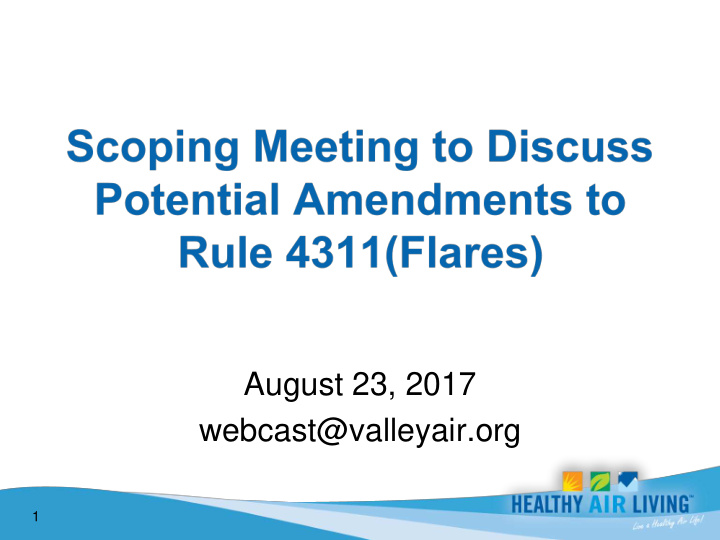



August 23, 2017 webcast@valleyair.org 1
• Initiate public process for rulemaking and engage stakeholders • Provide background on flares • Review current District flare requirements • Review completed further studies • Review commitment to amend Rule 4311 • Review flare minimization practices • Review flare control technologies • Identify next steps 2
• Flares serve two basic functions – Emission control device for VOC emissions – Safety device during unforeseeable and unpreventable emergency situations • Utilized by diverse group of industries – Oil and gas production – Petroleum refining – Natural gas processing – Natural gas transmission – Wastewater treatment (wastewater treatment plants, cheese production, wineries, dairy, beef packer) – Miscellaneous (correctional facility, flat glass manufacturer) • The majority of Valley flares are standby or emergency flares – Standby: utilized to dispose of gas during maintenance or periods when gas cannot be disposed of through normal means – Emergency: only used during unforeseeable and unpreventable emergency situations 3
• District Rule 4311 adopted June 2002 and amended in 2009 to add a number of new requirements, including annual reporting and flare minimization practices – NOx limit as low as 0.068 lb-NOx/MMBtu (53 ppmv NOx) – Proper operation (i.e., ignition system, heat sensors, etc.) – Flare minimization plans – Reporting of unplanned flaring event within 24 hours – Vent gas composition monitoring – Reporting of monitoring system inoperation – Alternate methods of monitoring – Video monitoring – Most stringent rule compared to other regions (North Dakota, Santa Barbara, etc.) 4
• 2014 Further Study – Commitment in 2012 PM2.5 Plan and 2013 Plan Ozone – Operators of flares in Valley subject to most stringent requirements and were implementing alternatives and committing to activities that reduce flaring • 2015 Further Study – Commitment in 2015 PM2.5 Plan – Reviewed flare minimization practices and technology – Ultra low NOx technologies with potential to further reduce emissions from flaring have recently become available requiring further feasibility evaluation – District identified minimization practices currently performed at facilities that have the potential to be applied to other facilities 5
• Enormous reductions needed to demonstrate attainment with latest federal ozone and PM2.5 standards – District has committed to leave no stone unturned • Latest flare further study found potential additional flare minimization practices and new ultra-low NOx technologies • District committed in 2016 Ozone Plan to work closely with affected operators to undergo regulatory amendment process for Rule 4311 to: – Include additional flare minimization requirements, where technologically achievable and economically feasible – Include additional ultra-low NOx flare emission limitations for existing and new flaring activities at Valley facilities, where technologically achievable and economically feasible • District in process of developing attainment strategy to address multiple federal PM2.5 standards • State recently adopted oil/gas greenhouse gas emission regulations will result in increased flaring activities and emissions (will require 15 ppmv NOx by 2019) 6
• Alternatives to flaring – Use gas as a fuel for equipment rather than flaring – Send oilfield gas to a sales gas line or compress and transport • Maintenance and testing – Install high-pressure alarms on process vessels – Inspect pressure relief valves routinely to ensure proper operation • Reduction in flaring during maintenance and shutdowns – Perform maintenance on one area without impacting other operations on site – Curtail oil/gas production during planned shutdown of sales line – Gas storage systems • Redundant systems – Redundant compressors – Redundant digester gas-fired turbines • Procedures to prevent/mitigate flaring due to power outages – Backup generators – Power outage alarm 7
• Questions/issues to be addressed – Technical feasibility of implementing flare minimization practices by various sources/processes – Economic feasibility of each flare minimization practice – Other potential minimization practices not yet identified 8
• District has conducted preliminary research on potential ultra-low NOx flaring or alternative incineration technologies: – Aereon Certified Ultra-Low Emissions Burner (installations in Santa Barbara APCD, source tested below 8 ppmv) – Coyote VOC Destruction Device (installations in San Joaquin Valley, manufacturer claim 20 ppmv) – John Zink “ZULE” enclosed ground flare (installations at landfills, source tested at 12 ppmv) – ClearSign Duplex Technology (manufacturer claim 15 ppmv) 9
• Questions/issues to be addressed – Identification of sources that technology can be applied to – Additional infrastructure needs (e.g., electricity, gas treatment, etc.) – Ability to handle large volume of gas – Ability to address large fluctuations in gas flowrate – Ability to handle gas with low or high heating value – Reliability – Cost feasibility – Other technologies not yet identified 10
• Hold focus workgroup meetings to evaluate and discuss flare minimization practices (September/October 2017) • Evaluate ultra-low NOx flare technologies and cost effectiveness • Develop draft staff report • Develop draft amended rule • Hold public workshop (October/November 2017) • Finalize staff report • Finalize amended rule • Adopt rule at Board hearing (late 2017/early 2018) 11
• Contact: Kevin M. Wing • Mail: San Joaquin Valley APCD 1990 E. Gettysburg Ave Fresno, CA 93726 • Phone: (559) 230-5800 • Fax: (559) 230-6064 • Email: kevin.wing@valleyair.org 12
webcast@valleyair.org 13
Recommend
More recommend